Analyzing Lifestyle Factors in Cardiovascular Disease & Nursing's Role
VerifiedAdded on 2023/06/15
|10
|3235
|283
Essay
AI Summary
This essay explores the critical link between lifestyle factors and the development of cardiovascular disease (CVD), which is a leading cause of non-communicable disease mortality. It discusses how modifiable risk factors like unhealthy diet, physical inactivity, alcohol and tobacco use significantly contribute to CVD. The essay highlights the importance of a life course approach, emphasizing how choices during gestation, childhood, adolescence, and adulthood impact later-life well-being and CVD risk. It further emphasizes the ABCDES (Alcohol, Blood pressure, Cholesterol, Diabetes, Exercise, and Smoking) of a healthy lifestyle in reducing CVD prevalence. The role of psychological factors like stress and anxiety is also acknowledged. Finally, the essay addresses the relevance of this relationship to the nursing profession, underscoring the crucial role nurses play in patient education, self-management, and overall prevention and management of CVD, thus reducing mortality and improving quality of life. This assignment is available on Desklib, a platform offering a variety of study resources for students.

Cardiovascular disease.
Paraphrase This Document
Need a fresh take? Get an instant paraphrase of this document with our AI Paraphraser
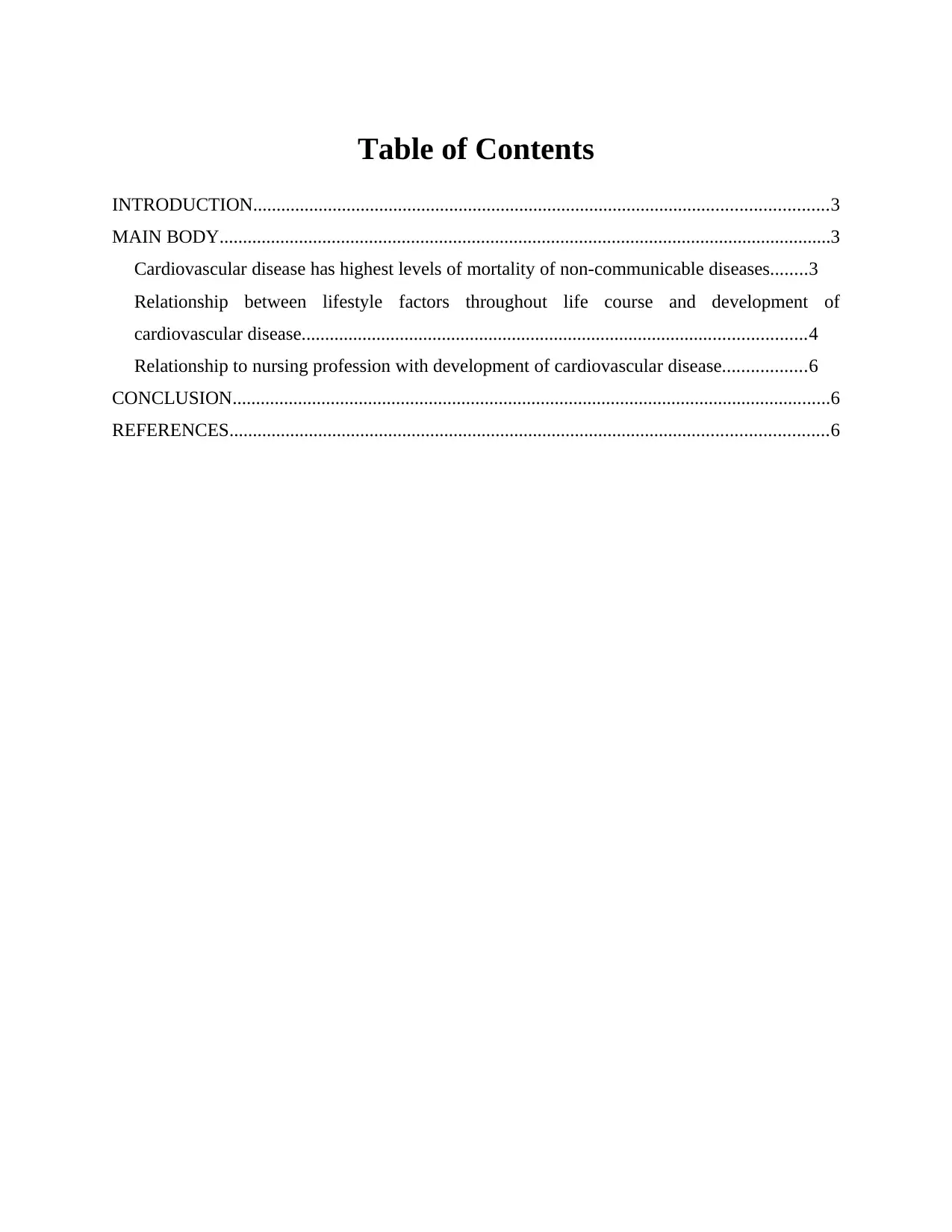
Table of Contents
INTRODUCTION...........................................................................................................................3
MAIN BODY...................................................................................................................................3
Cardiovascular disease has highest levels of mortality of non-communicable diseases........3
Relationship between lifestyle factors throughout life course and development of
cardiovascular disease............................................................................................................4
Relationship to nursing profession with development of cardiovascular disease..................6
CONCLUSION................................................................................................................................6
REFERENCES................................................................................................................................6
INTRODUCTION...........................................................................................................................3
MAIN BODY...................................................................................................................................3
Cardiovascular disease has highest levels of mortality of non-communicable diseases........3
Relationship between lifestyle factors throughout life course and development of
cardiovascular disease............................................................................................................4
Relationship to nursing profession with development of cardiovascular disease..................6
CONCLUSION................................................................................................................................6
REFERENCES................................................................................................................................6
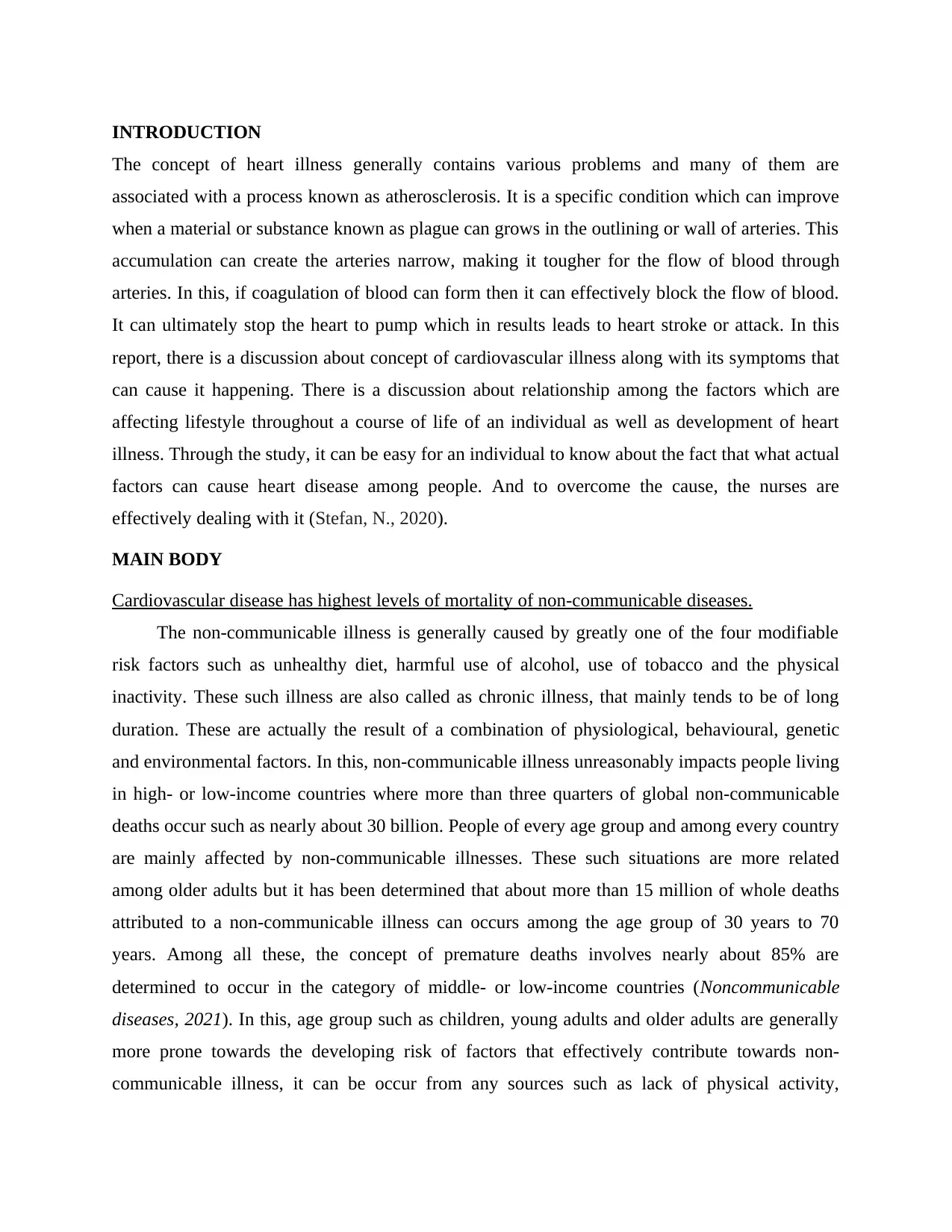
INTRODUCTION
The concept of heart illness generally contains various problems and many of them are
associated with a process known as atherosclerosis. It is a specific condition which can improve
when a material or substance known as plague can grows in the outlining or wall of arteries. This
accumulation can create the arteries narrow, making it tougher for the flow of blood through
arteries. In this, if coagulation of blood can form then it can effectively block the flow of blood.
It can ultimately stop the heart to pump which in results leads to heart stroke or attack. In this
report, there is a discussion about concept of cardiovascular illness along with its symptoms that
can cause it happening. There is a discussion about relationship among the factors which are
affecting lifestyle throughout a course of life of an individual as well as development of heart
illness. Through the study, it can be easy for an individual to know about the fact that what actual
factors can cause heart disease among people. And to overcome the cause, the nurses are
effectively dealing with it (Stefan, N., 2020).
MAIN BODY
Cardiovascular disease has highest levels of mortality of non-communicable diseases.
The non-communicable illness is generally caused by greatly one of the four modifiable
risk factors such as unhealthy diet, harmful use of alcohol, use of tobacco and the physical
inactivity. These such illness are also called as chronic illness, that mainly tends to be of long
duration. These are actually the result of a combination of physiological, behavioural, genetic
and environmental factors. In this, non-communicable illness unreasonably impacts people living
in high- or low-income countries where more than three quarters of global non-communicable
deaths occur such as nearly about 30 billion. People of every age group and among every country
are mainly affected by non-communicable illnesses. These such situations are more related
among older adults but it has been determined that about more than 15 million of whole deaths
attributed to a non-communicable illness can occurs among the age group of 30 years to 70
years. Among all these, the concept of premature deaths involves nearly about 85% are
determined to occur in the category of middle- or low-income countries (Noncommunicable
diseases, 2021). In this, age group such as children, young adults and older adults are generally
more prone towards the developing risk of factors that effectively contribute towards non-
communicable illness, it can be occur from any sources such as lack of physical activity,
The concept of heart illness generally contains various problems and many of them are
associated with a process known as atherosclerosis. It is a specific condition which can improve
when a material or substance known as plague can grows in the outlining or wall of arteries. This
accumulation can create the arteries narrow, making it tougher for the flow of blood through
arteries. In this, if coagulation of blood can form then it can effectively block the flow of blood.
It can ultimately stop the heart to pump which in results leads to heart stroke or attack. In this
report, there is a discussion about concept of cardiovascular illness along with its symptoms that
can cause it happening. There is a discussion about relationship among the factors which are
affecting lifestyle throughout a course of life of an individual as well as development of heart
illness. Through the study, it can be easy for an individual to know about the fact that what actual
factors can cause heart disease among people. And to overcome the cause, the nurses are
effectively dealing with it (Stefan, N., 2020).
MAIN BODY
Cardiovascular disease has highest levels of mortality of non-communicable diseases.
The non-communicable illness is generally caused by greatly one of the four modifiable
risk factors such as unhealthy diet, harmful use of alcohol, use of tobacco and the physical
inactivity. These such illness are also called as chronic illness, that mainly tends to be of long
duration. These are actually the result of a combination of physiological, behavioural, genetic
and environmental factors. In this, non-communicable illness unreasonably impacts people living
in high- or low-income countries where more than three quarters of global non-communicable
deaths occur such as nearly about 30 billion. People of every age group and among every country
are mainly affected by non-communicable illnesses. These such situations are more related
among older adults but it has been determined that about more than 15 million of whole deaths
attributed to a non-communicable illness can occurs among the age group of 30 years to 70
years. Among all these, the concept of premature deaths involves nearly about 85% are
determined to occur in the category of middle- or low-income countries (Noncommunicable
diseases, 2021). In this, age group such as children, young adults and older adults are generally
more prone towards the developing risk of factors that effectively contribute towards non-
communicable illness, it can be occur from any sources such as lack of physical activity,
⊘ This is a preview!⊘
Do you want full access?
Subscribe today to unlock all pages.

Trusted by 1+ million students worldwide
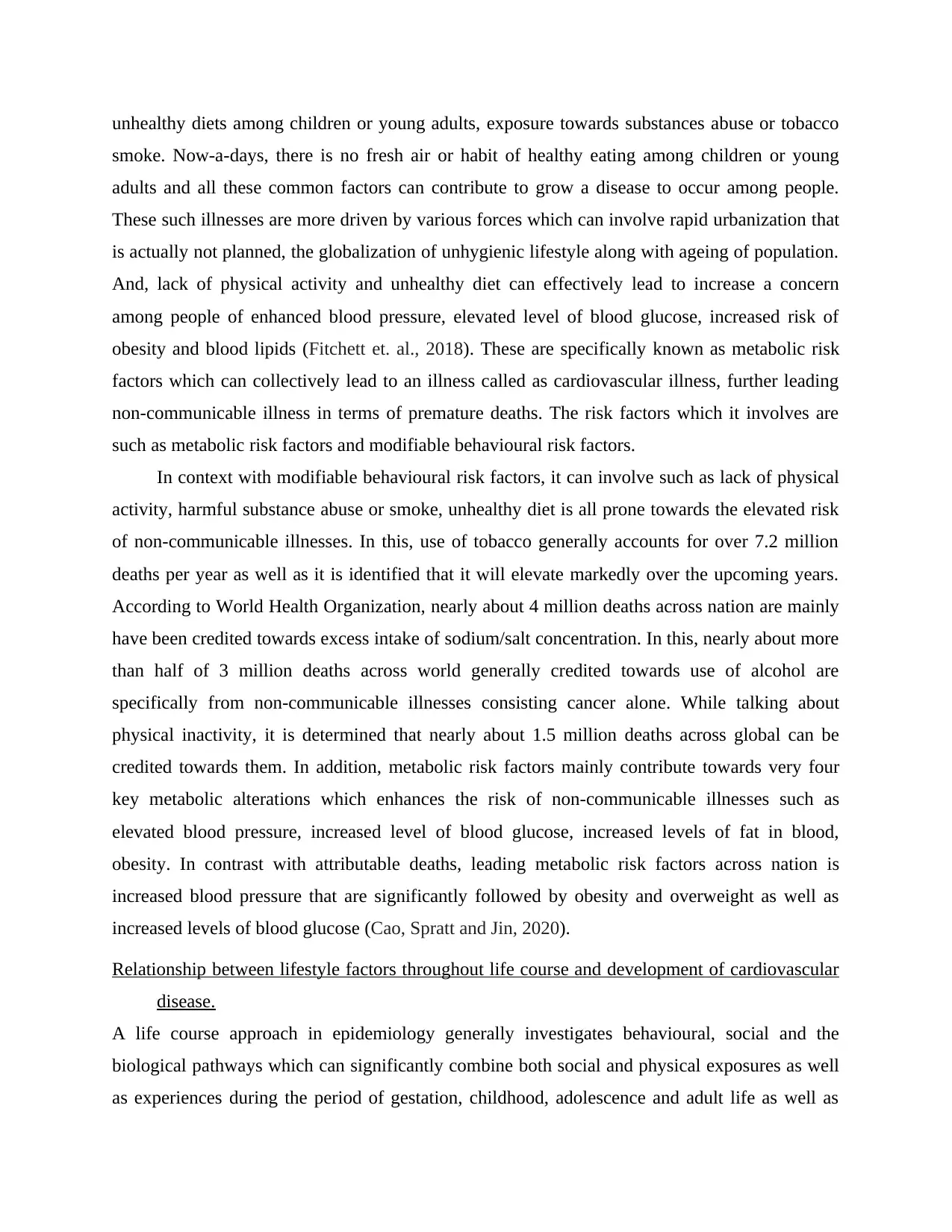
unhealthy diets among children or young adults, exposure towards substances abuse or tobacco
smoke. Now-a-days, there is no fresh air or habit of healthy eating among children or young
adults and all these common factors can contribute to grow a disease to occur among people.
These such illnesses are more driven by various forces which can involve rapid urbanization that
is actually not planned, the globalization of unhygienic lifestyle along with ageing of population.
And, lack of physical activity and unhealthy diet can effectively lead to increase a concern
among people of enhanced blood pressure, elevated level of blood glucose, increased risk of
obesity and blood lipids (Fitchett et. al., 2018). These are specifically known as metabolic risk
factors which can collectively lead to an illness called as cardiovascular illness, further leading
non-communicable illness in terms of premature deaths. The risk factors which it involves are
such as metabolic risk factors and modifiable behavioural risk factors.
In context with modifiable behavioural risk factors, it can involve such as lack of physical
activity, harmful substance abuse or smoke, unhealthy diet is all prone towards the elevated risk
of non-communicable illnesses. In this, use of tobacco generally accounts for over 7.2 million
deaths per year as well as it is identified that it will elevate markedly over the upcoming years.
According to World Health Organization, nearly about 4 million deaths across nation are mainly
have been credited towards excess intake of sodium/salt concentration. In this, nearly about more
than half of 3 million deaths across world generally credited towards use of alcohol are
specifically from non-communicable illnesses consisting cancer alone. While talking about
physical inactivity, it is determined that nearly about 1.5 million deaths across global can be
credited towards them. In addition, metabolic risk factors mainly contribute towards very four
key metabolic alterations which enhances the risk of non-communicable illnesses such as
elevated blood pressure, increased level of blood glucose, increased levels of fat in blood,
obesity. In contrast with attributable deaths, leading metabolic risk factors across nation is
increased blood pressure that are significantly followed by obesity and overweight as well as
increased levels of blood glucose (Cao, Spratt and Jin, 2020).
Relationship between lifestyle factors throughout life course and development of cardiovascular
disease.
A life course approach in epidemiology generally investigates behavioural, social and the
biological pathways which can significantly combine both social and physical exposures as well
as experiences during the period of gestation, childhood, adolescence and adult life as well as
smoke. Now-a-days, there is no fresh air or habit of healthy eating among children or young
adults and all these common factors can contribute to grow a disease to occur among people.
These such illnesses are more driven by various forces which can involve rapid urbanization that
is actually not planned, the globalization of unhygienic lifestyle along with ageing of population.
And, lack of physical activity and unhealthy diet can effectively lead to increase a concern
among people of enhanced blood pressure, elevated level of blood glucose, increased risk of
obesity and blood lipids (Fitchett et. al., 2018). These are specifically known as metabolic risk
factors which can collectively lead to an illness called as cardiovascular illness, further leading
non-communicable illness in terms of premature deaths. The risk factors which it involves are
such as metabolic risk factors and modifiable behavioural risk factors.
In context with modifiable behavioural risk factors, it can involve such as lack of physical
activity, harmful substance abuse or smoke, unhealthy diet is all prone towards the elevated risk
of non-communicable illnesses. In this, use of tobacco generally accounts for over 7.2 million
deaths per year as well as it is identified that it will elevate markedly over the upcoming years.
According to World Health Organization, nearly about 4 million deaths across nation are mainly
have been credited towards excess intake of sodium/salt concentration. In this, nearly about more
than half of 3 million deaths across world generally credited towards use of alcohol are
specifically from non-communicable illnesses consisting cancer alone. While talking about
physical inactivity, it is determined that nearly about 1.5 million deaths across global can be
credited towards them. In addition, metabolic risk factors mainly contribute towards very four
key metabolic alterations which enhances the risk of non-communicable illnesses such as
elevated blood pressure, increased level of blood glucose, increased levels of fat in blood,
obesity. In contrast with attributable deaths, leading metabolic risk factors across nation is
increased blood pressure that are significantly followed by obesity and overweight as well as
increased levels of blood glucose (Cao, Spratt and Jin, 2020).
Relationship between lifestyle factors throughout life course and development of cardiovascular
disease.
A life course approach in epidemiology generally investigates behavioural, social and the
biological pathways which can significantly combine both social and physical exposures as well
as experiences during the period of gestation, childhood, adolescence and adult life as well as
Paraphrase This Document
Need a fresh take? Get an instant paraphrase of this document with our AI Paraphraser
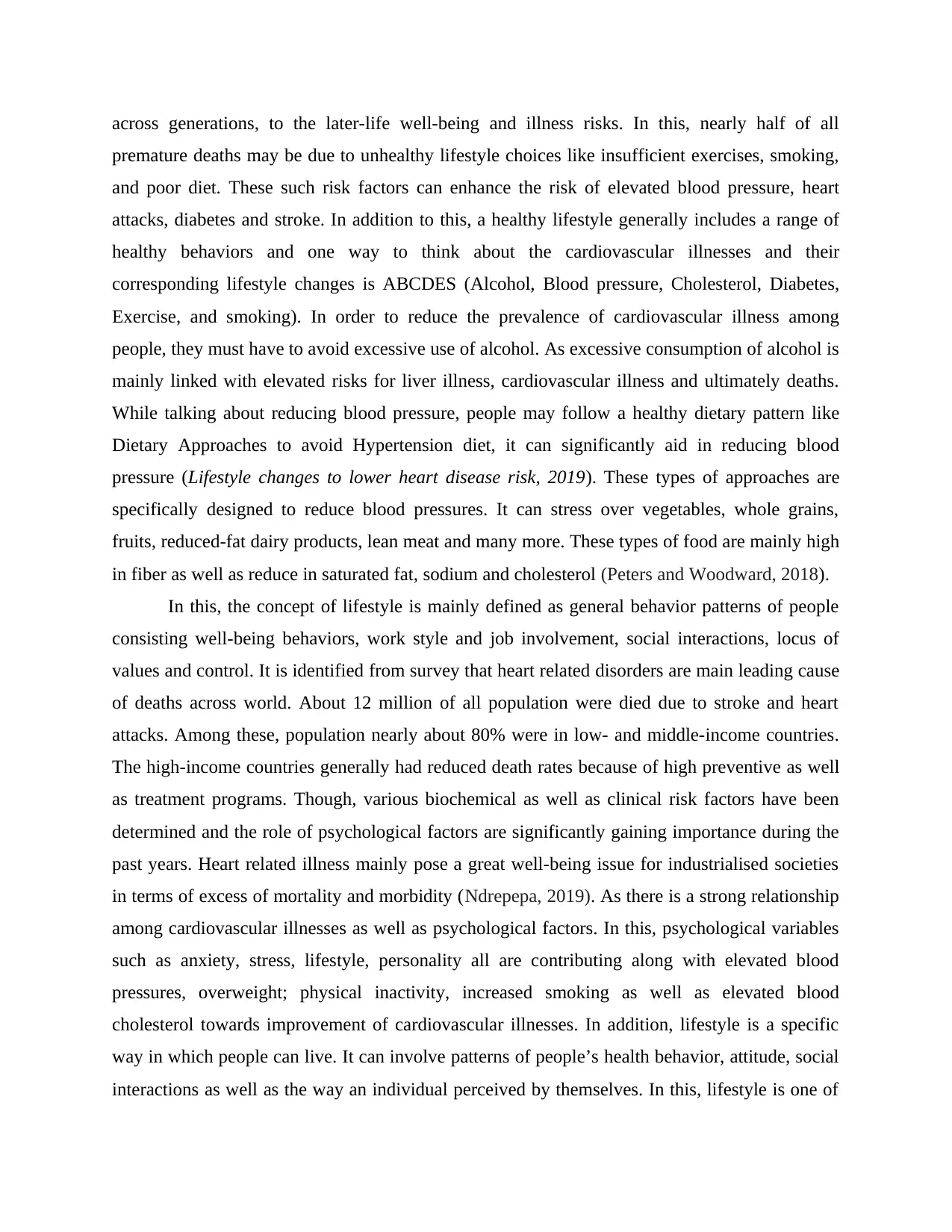
across generations, to the later-life well-being and illness risks. In this, nearly half of all
premature deaths may be due to unhealthy lifestyle choices like insufficient exercises, smoking,
and poor diet. These such risk factors can enhance the risk of elevated blood pressure, heart
attacks, diabetes and stroke. In addition to this, a healthy lifestyle generally includes a range of
healthy behaviors and one way to think about the cardiovascular illnesses and their
corresponding lifestyle changes is ABCDES (Alcohol, Blood pressure, Cholesterol, Diabetes,
Exercise, and smoking). In order to reduce the prevalence of cardiovascular illness among
people, they must have to avoid excessive use of alcohol. As excessive consumption of alcohol is
mainly linked with elevated risks for liver illness, cardiovascular illness and ultimately deaths.
While talking about reducing blood pressure, people may follow a healthy dietary pattern like
Dietary Approaches to avoid Hypertension diet, it can significantly aid in reducing blood
pressure (Lifestyle changes to lower heart disease risk, 2019). These types of approaches are
specifically designed to reduce blood pressures. It can stress over vegetables, whole grains,
fruits, reduced-fat dairy products, lean meat and many more. These types of food are mainly high
in fiber as well as reduce in saturated fat, sodium and cholesterol (Peters and Woodward, 2018).
In this, the concept of lifestyle is mainly defined as general behavior patterns of people
consisting well-being behaviors, work style and job involvement, social interactions, locus of
values and control. It is identified from survey that heart related disorders are main leading cause
of deaths across world. About 12 million of all population were died due to stroke and heart
attacks. Among these, population nearly about 80% were in low- and middle-income countries.
The high-income countries generally had reduced death rates because of high preventive as well
as treatment programs. Though, various biochemical as well as clinical risk factors have been
determined and the role of psychological factors are significantly gaining importance during the
past years. Heart related illness mainly pose a great well-being issue for industrialised societies
in terms of excess of mortality and morbidity (Ndrepepa, 2019). As there is a strong relationship
among cardiovascular illnesses as well as psychological factors. In this, psychological variables
such as anxiety, stress, lifestyle, personality all are contributing along with elevated blood
pressures, overweight; physical inactivity, increased smoking as well as elevated blood
cholesterol towards improvement of cardiovascular illnesses. In addition, lifestyle is a specific
way in which people can live. It can involve patterns of people’s health behavior, attitude, social
interactions as well as the way an individual perceived by themselves. In this, lifestyle is one of
premature deaths may be due to unhealthy lifestyle choices like insufficient exercises, smoking,
and poor diet. These such risk factors can enhance the risk of elevated blood pressure, heart
attacks, diabetes and stroke. In addition to this, a healthy lifestyle generally includes a range of
healthy behaviors and one way to think about the cardiovascular illnesses and their
corresponding lifestyle changes is ABCDES (Alcohol, Blood pressure, Cholesterol, Diabetes,
Exercise, and smoking). In order to reduce the prevalence of cardiovascular illness among
people, they must have to avoid excessive use of alcohol. As excessive consumption of alcohol is
mainly linked with elevated risks for liver illness, cardiovascular illness and ultimately deaths.
While talking about reducing blood pressure, people may follow a healthy dietary pattern like
Dietary Approaches to avoid Hypertension diet, it can significantly aid in reducing blood
pressure (Lifestyle changes to lower heart disease risk, 2019). These types of approaches are
specifically designed to reduce blood pressures. It can stress over vegetables, whole grains,
fruits, reduced-fat dairy products, lean meat and many more. These types of food are mainly high
in fiber as well as reduce in saturated fat, sodium and cholesterol (Peters and Woodward, 2018).
In this, the concept of lifestyle is mainly defined as general behavior patterns of people
consisting well-being behaviors, work style and job involvement, social interactions, locus of
values and control. It is identified from survey that heart related disorders are main leading cause
of deaths across world. About 12 million of all population were died due to stroke and heart
attacks. Among these, population nearly about 80% were in low- and middle-income countries.
The high-income countries generally had reduced death rates because of high preventive as well
as treatment programs. Though, various biochemical as well as clinical risk factors have been
determined and the role of psychological factors are significantly gaining importance during the
past years. Heart related illness mainly pose a great well-being issue for industrialised societies
in terms of excess of mortality and morbidity (Ndrepepa, 2019). As there is a strong relationship
among cardiovascular illnesses as well as psychological factors. In this, psychological variables
such as anxiety, stress, lifestyle, personality all are contributing along with elevated blood
pressures, overweight; physical inactivity, increased smoking as well as elevated blood
cholesterol towards improvement of cardiovascular illnesses. In addition, lifestyle is a specific
way in which people can live. It can involve patterns of people’s health behavior, attitude, social
interactions as well as the way an individual perceived by themselves. In this, lifestyle is one of
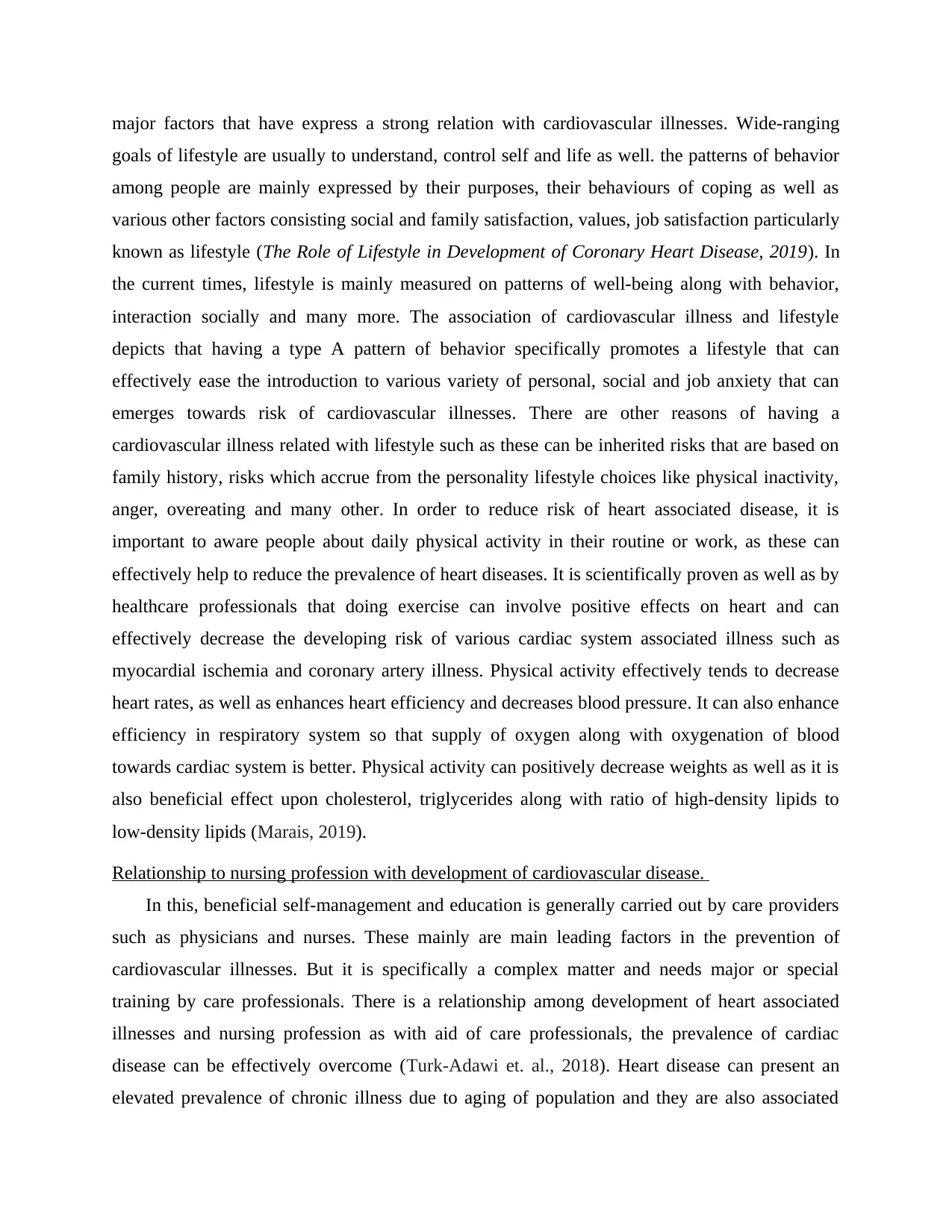
major factors that have express a strong relation with cardiovascular illnesses. Wide-ranging
goals of lifestyle are usually to understand, control self and life as well. the patterns of behavior
among people are mainly expressed by their purposes, their behaviours of coping as well as
various other factors consisting social and family satisfaction, values, job satisfaction particularly
known as lifestyle (The Role of Lifestyle in Development of Coronary Heart Disease, 2019). In
the current times, lifestyle is mainly measured on patterns of well-being along with behavior,
interaction socially and many more. The association of cardiovascular illness and lifestyle
depicts that having a type A pattern of behavior specifically promotes a lifestyle that can
effectively ease the introduction to various variety of personal, social and job anxiety that can
emerges towards risk of cardiovascular illnesses. There are other reasons of having a
cardiovascular illness related with lifestyle such as these can be inherited risks that are based on
family history, risks which accrue from the personality lifestyle choices like physical inactivity,
anger, overeating and many other. In order to reduce risk of heart associated disease, it is
important to aware people about daily physical activity in their routine or work, as these can
effectively help to reduce the prevalence of heart diseases. It is scientifically proven as well as by
healthcare professionals that doing exercise can involve positive effects on heart and can
effectively decrease the developing risk of various cardiac system associated illness such as
myocardial ischemia and coronary artery illness. Physical activity effectively tends to decrease
heart rates, as well as enhances heart efficiency and decreases blood pressure. It can also enhance
efficiency in respiratory system so that supply of oxygen along with oxygenation of blood
towards cardiac system is better. Physical activity can positively decrease weights as well as it is
also beneficial effect upon cholesterol, triglycerides along with ratio of high-density lipids to
low-density lipids (Marais, 2019).
Relationship to nursing profession with development of cardiovascular disease.
In this, beneficial self-management and education is generally carried out by care providers
such as physicians and nurses. These mainly are main leading factors in the prevention of
cardiovascular illnesses. But it is specifically a complex matter and needs major or special
training by care professionals. There is a relationship among development of heart associated
illnesses and nursing profession as with aid of care professionals, the prevalence of cardiac
disease can be effectively overcome (Turk-Adawi et. al., 2018). Heart disease can present an
elevated prevalence of chronic illness due to aging of population and they are also associated
goals of lifestyle are usually to understand, control self and life as well. the patterns of behavior
among people are mainly expressed by their purposes, their behaviours of coping as well as
various other factors consisting social and family satisfaction, values, job satisfaction particularly
known as lifestyle (The Role of Lifestyle in Development of Coronary Heart Disease, 2019). In
the current times, lifestyle is mainly measured on patterns of well-being along with behavior,
interaction socially and many more. The association of cardiovascular illness and lifestyle
depicts that having a type A pattern of behavior specifically promotes a lifestyle that can
effectively ease the introduction to various variety of personal, social and job anxiety that can
emerges towards risk of cardiovascular illnesses. There are other reasons of having a
cardiovascular illness related with lifestyle such as these can be inherited risks that are based on
family history, risks which accrue from the personality lifestyle choices like physical inactivity,
anger, overeating and many other. In order to reduce risk of heart associated disease, it is
important to aware people about daily physical activity in their routine or work, as these can
effectively help to reduce the prevalence of heart diseases. It is scientifically proven as well as by
healthcare professionals that doing exercise can involve positive effects on heart and can
effectively decrease the developing risk of various cardiac system associated illness such as
myocardial ischemia and coronary artery illness. Physical activity effectively tends to decrease
heart rates, as well as enhances heart efficiency and decreases blood pressure. It can also enhance
efficiency in respiratory system so that supply of oxygen along with oxygenation of blood
towards cardiac system is better. Physical activity can positively decrease weights as well as it is
also beneficial effect upon cholesterol, triglycerides along with ratio of high-density lipids to
low-density lipids (Marais, 2019).
Relationship to nursing profession with development of cardiovascular disease.
In this, beneficial self-management and education is generally carried out by care providers
such as physicians and nurses. These mainly are main leading factors in the prevention of
cardiovascular illnesses. But it is specifically a complex matter and needs major or special
training by care professionals. There is a relationship among development of heart associated
illnesses and nursing profession as with aid of care professionals, the prevalence of cardiac
disease can be effectively overcome (Turk-Adawi et. al., 2018). Heart disease can present an
elevated prevalence of chronic illness due to aging of population and they are also associated
⊘ This is a preview!⊘
Do you want full access?
Subscribe today to unlock all pages.

Trusted by 1+ million students worldwide
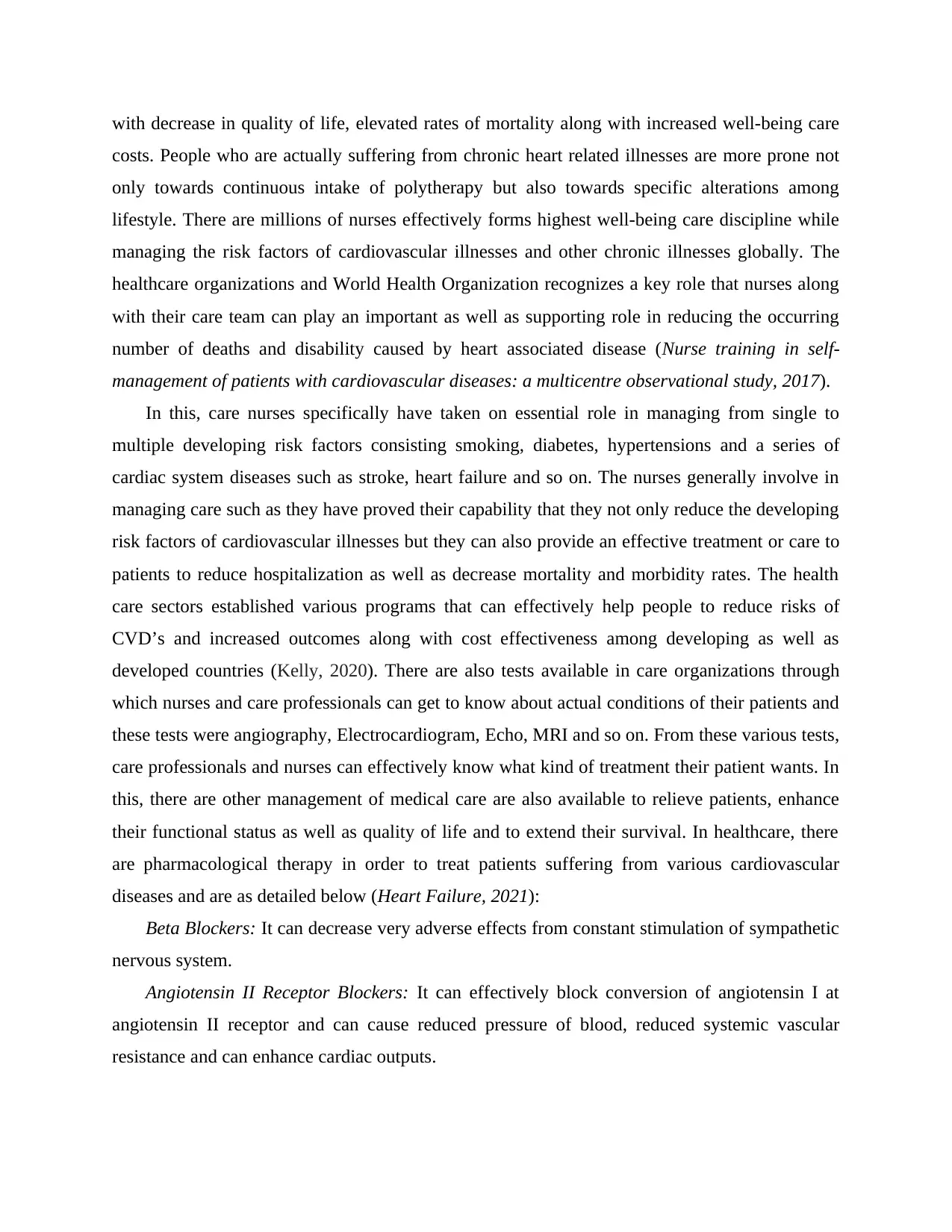
with decrease in quality of life, elevated rates of mortality along with increased well-being care
costs. People who are actually suffering from chronic heart related illnesses are more prone not
only towards continuous intake of polytherapy but also towards specific alterations among
lifestyle. There are millions of nurses effectively forms highest well-being care discipline while
managing the risk factors of cardiovascular illnesses and other chronic illnesses globally. The
healthcare organizations and World Health Organization recognizes a key role that nurses along
with their care team can play an important as well as supporting role in reducing the occurring
number of deaths and disability caused by heart associated disease (Nurse training in self-
management of patients with cardiovascular diseases: a multicentre observational study, 2017).
In this, care nurses specifically have taken on essential role in managing from single to
multiple developing risk factors consisting smoking, diabetes, hypertensions and a series of
cardiac system diseases such as stroke, heart failure and so on. The nurses generally involve in
managing care such as they have proved their capability that they not only reduce the developing
risk factors of cardiovascular illnesses but they can also provide an effective treatment or care to
patients to reduce hospitalization as well as decrease mortality and morbidity rates. The health
care sectors established various programs that can effectively help people to reduce risks of
CVD’s and increased outcomes along with cost effectiveness among developing as well as
developed countries (Kelly, 2020). There are also tests available in care organizations through
which nurses and care professionals can get to know about actual conditions of their patients and
these tests were angiography, Electrocardiogram, Echo, MRI and so on. From these various tests,
care professionals and nurses can effectively know what kind of treatment their patient wants. In
this, there are other management of medical care are also available to relieve patients, enhance
their functional status as well as quality of life and to extend their survival. In healthcare, there
are pharmacological therapy in order to treat patients suffering from various cardiovascular
diseases and are as detailed below (Heart Failure, 2021):
Beta Blockers: It can decrease very adverse effects from constant stimulation of sympathetic
nervous system.
Angiotensin II Receptor Blockers: It can effectively block conversion of angiotensin I at
angiotensin II receptor and can cause reduced pressure of blood, reduced systemic vascular
resistance and can enhance cardiac outputs.
costs. People who are actually suffering from chronic heart related illnesses are more prone not
only towards continuous intake of polytherapy but also towards specific alterations among
lifestyle. There are millions of nurses effectively forms highest well-being care discipline while
managing the risk factors of cardiovascular illnesses and other chronic illnesses globally. The
healthcare organizations and World Health Organization recognizes a key role that nurses along
with their care team can play an important as well as supporting role in reducing the occurring
number of deaths and disability caused by heart associated disease (Nurse training in self-
management of patients with cardiovascular diseases: a multicentre observational study, 2017).
In this, care nurses specifically have taken on essential role in managing from single to
multiple developing risk factors consisting smoking, diabetes, hypertensions and a series of
cardiac system diseases such as stroke, heart failure and so on. The nurses generally involve in
managing care such as they have proved their capability that they not only reduce the developing
risk factors of cardiovascular illnesses but they can also provide an effective treatment or care to
patients to reduce hospitalization as well as decrease mortality and morbidity rates. The health
care sectors established various programs that can effectively help people to reduce risks of
CVD’s and increased outcomes along with cost effectiveness among developing as well as
developed countries (Kelly, 2020). There are also tests available in care organizations through
which nurses and care professionals can get to know about actual conditions of their patients and
these tests were angiography, Electrocardiogram, Echo, MRI and so on. From these various tests,
care professionals and nurses can effectively know what kind of treatment their patient wants. In
this, there are other management of medical care are also available to relieve patients, enhance
their functional status as well as quality of life and to extend their survival. In healthcare, there
are pharmacological therapy in order to treat patients suffering from various cardiovascular
diseases and are as detailed below (Heart Failure, 2021):
Beta Blockers: It can decrease very adverse effects from constant stimulation of sympathetic
nervous system.
Angiotensin II Receptor Blockers: It can effectively block conversion of angiotensin I at
angiotensin II receptor and can cause reduced pressure of blood, reduced systemic vascular
resistance and can enhance cardiac outputs.
Paraphrase This Document
Need a fresh take? Get an instant paraphrase of this document with our AI Paraphraser
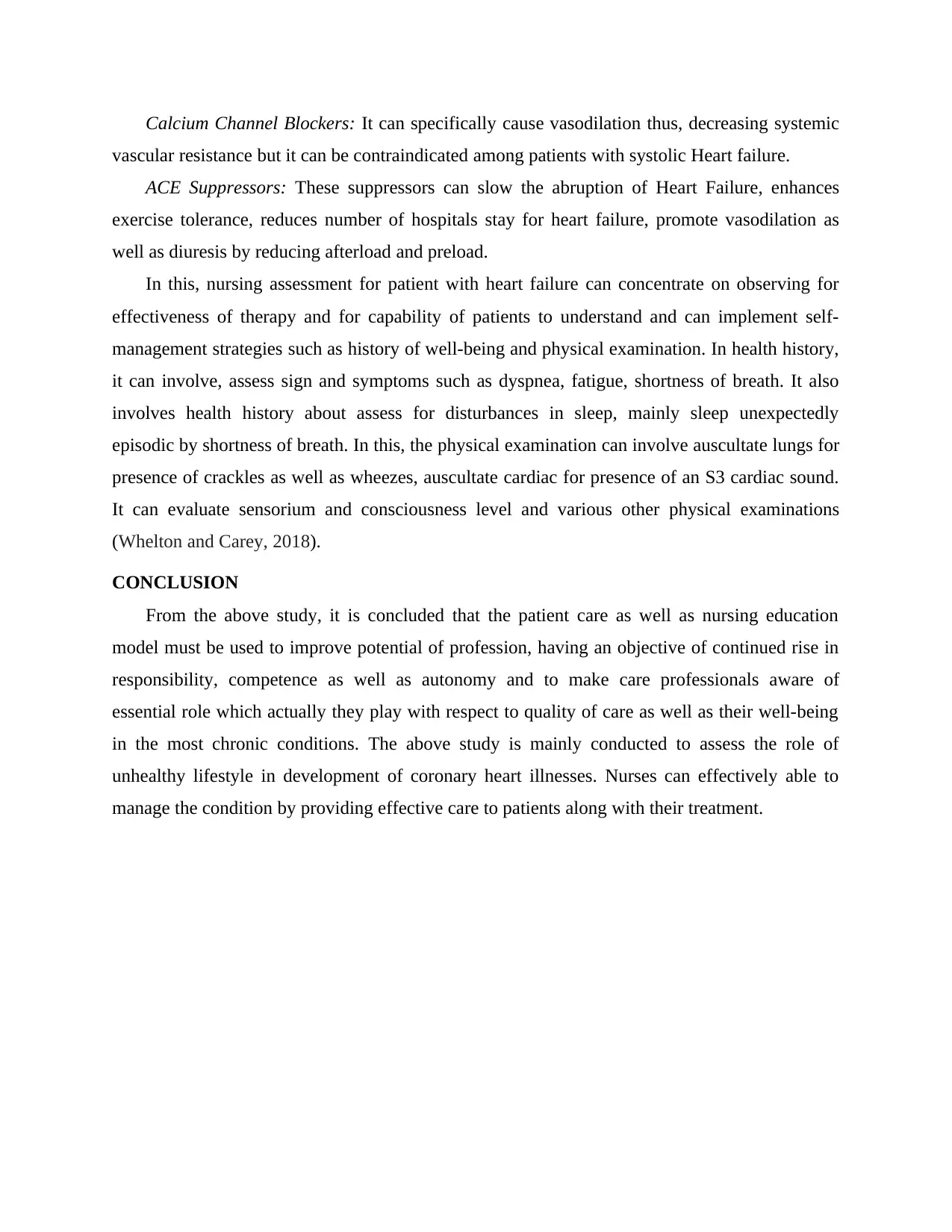
Calcium Channel Blockers: It can specifically cause vasodilation thus, decreasing systemic
vascular resistance but it can be contraindicated among patients with systolic Heart failure.
ACE Suppressors: These suppressors can slow the abruption of Heart Failure, enhances
exercise tolerance, reduces number of hospitals stay for heart failure, promote vasodilation as
well as diuresis by reducing afterload and preload.
In this, nursing assessment for patient with heart failure can concentrate on observing for
effectiveness of therapy and for capability of patients to understand and can implement self-
management strategies such as history of well-being and physical examination. In health history,
it can involve, assess sign and symptoms such as dyspnea, fatigue, shortness of breath. It also
involves health history about assess for disturbances in sleep, mainly sleep unexpectedly
episodic by shortness of breath. In this, the physical examination can involve auscultate lungs for
presence of crackles as well as wheezes, auscultate cardiac for presence of an S3 cardiac sound.
It can evaluate sensorium and consciousness level and various other physical examinations
(Whelton and Carey, 2018).
CONCLUSION
From the above study, it is concluded that the patient care as well as nursing education
model must be used to improve potential of profession, having an objective of continued rise in
responsibility, competence as well as autonomy and to make care professionals aware of
essential role which actually they play with respect to quality of care as well as their well-being
in the most chronic conditions. The above study is mainly conducted to assess the role of
unhealthy lifestyle in development of coronary heart illnesses. Nurses can effectively able to
manage the condition by providing effective care to patients along with their treatment.
vascular resistance but it can be contraindicated among patients with systolic Heart failure.
ACE Suppressors: These suppressors can slow the abruption of Heart Failure, enhances
exercise tolerance, reduces number of hospitals stay for heart failure, promote vasodilation as
well as diuresis by reducing afterload and preload.
In this, nursing assessment for patient with heart failure can concentrate on observing for
effectiveness of therapy and for capability of patients to understand and can implement self-
management strategies such as history of well-being and physical examination. In health history,
it can involve, assess sign and symptoms such as dyspnea, fatigue, shortness of breath. It also
involves health history about assess for disturbances in sleep, mainly sleep unexpectedly
episodic by shortness of breath. In this, the physical examination can involve auscultate lungs for
presence of crackles as well as wheezes, auscultate cardiac for presence of an S3 cardiac sound.
It can evaluate sensorium and consciousness level and various other physical examinations
(Whelton and Carey, 2018).
CONCLUSION
From the above study, it is concluded that the patient care as well as nursing education
model must be used to improve potential of profession, having an objective of continued rise in
responsibility, competence as well as autonomy and to make care professionals aware of
essential role which actually they play with respect to quality of care as well as their well-being
in the most chronic conditions. The above study is mainly conducted to assess the role of
unhealthy lifestyle in development of coronary heart illnesses. Nurses can effectively able to
manage the condition by providing effective care to patients along with their treatment.
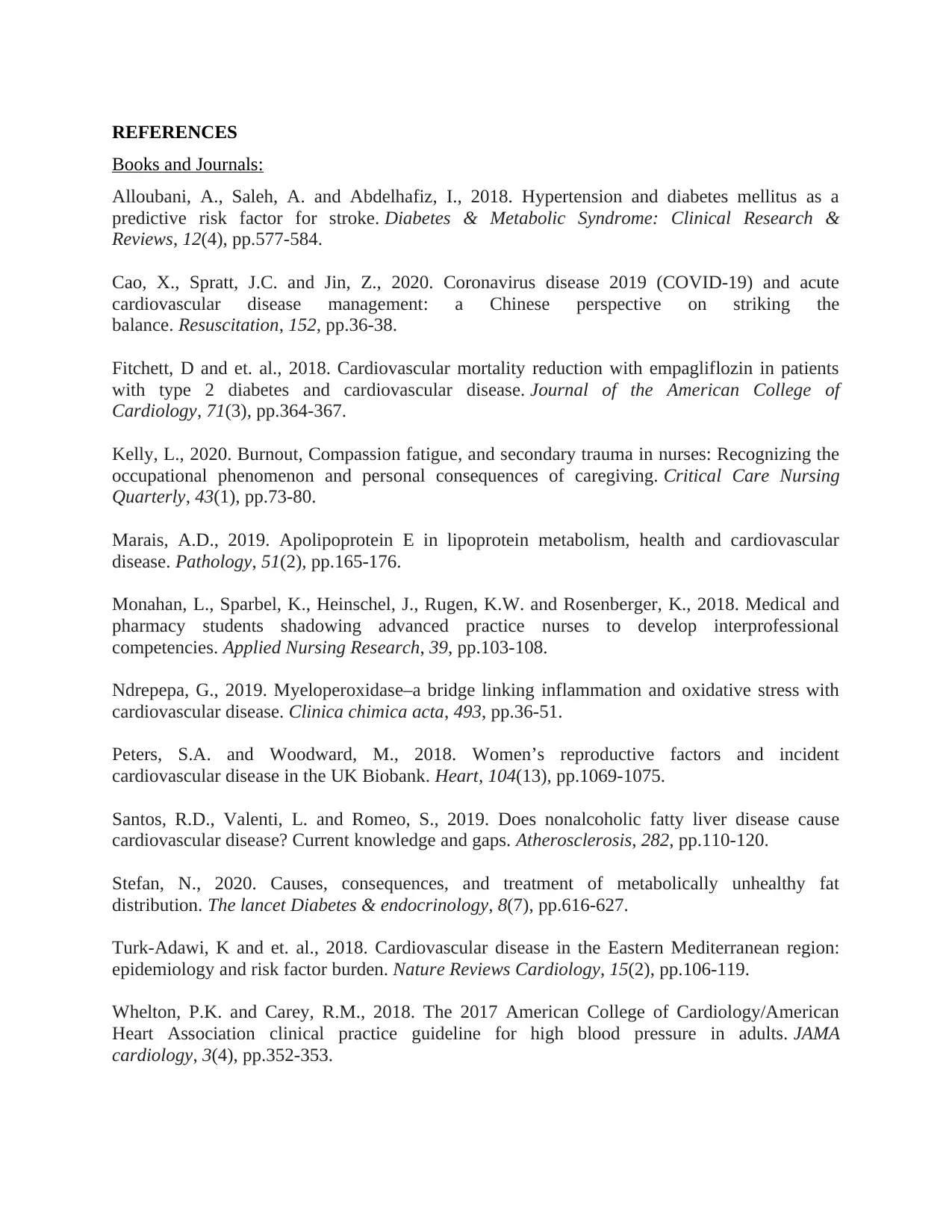
REFERENCES
Books and Journals:
Alloubani, A., Saleh, A. and Abdelhafiz, I., 2018. Hypertension and diabetes mellitus as a
predictive risk factor for stroke. Diabetes & Metabolic Syndrome: Clinical Research &
Reviews, 12(4), pp.577-584.
Cao, X., Spratt, J.C. and Jin, Z., 2020. Coronavirus disease 2019 (COVID-19) and acute
cardiovascular disease management: a Chinese perspective on striking the
balance. Resuscitation, 152, pp.36-38.
Fitchett, D and et. al., 2018. Cardiovascular mortality reduction with empagliflozin in patients
with type 2 diabetes and cardiovascular disease. Journal of the American College of
Cardiology, 71(3), pp.364-367.
Kelly, L., 2020. Burnout, Compassion fatigue, and secondary trauma in nurses: Recognizing the
occupational phenomenon and personal consequences of caregiving. Critical Care Nursing
Quarterly, 43(1), pp.73-80.
Marais, A.D., 2019. Apolipoprotein E in lipoprotein metabolism, health and cardiovascular
disease. Pathology, 51(2), pp.165-176.
Monahan, L., Sparbel, K., Heinschel, J., Rugen, K.W. and Rosenberger, K., 2018. Medical and
pharmacy students shadowing advanced practice nurses to develop interprofessional
competencies. Applied Nursing Research, 39, pp.103-108.
Ndrepepa, G., 2019. Myeloperoxidase–a bridge linking inflammation and oxidative stress with
cardiovascular disease. Clinica chimica acta, 493, pp.36-51.
Peters, S.A. and Woodward, M., 2018. Women’s reproductive factors and incident
cardiovascular disease in the UK Biobank. Heart, 104(13), pp.1069-1075.
Santos, R.D., Valenti, L. and Romeo, S., 2019. Does nonalcoholic fatty liver disease cause
cardiovascular disease? Current knowledge and gaps. Atherosclerosis, 282, pp.110-120.
Stefan, N., 2020. Causes, consequences, and treatment of metabolically unhealthy fat
distribution. The lancet Diabetes & endocrinology, 8(7), pp.616-627.
Turk-Adawi, K and et. al., 2018. Cardiovascular disease in the Eastern Mediterranean region:
epidemiology and risk factor burden. Nature Reviews Cardiology, 15(2), pp.106-119.
Whelton, P.K. and Carey, R.M., 2018. The 2017 American College of Cardiology/American
Heart Association clinical practice guideline for high blood pressure in adults. JAMA
cardiology, 3(4), pp.352-353.
Books and Journals:
Alloubani, A., Saleh, A. and Abdelhafiz, I., 2018. Hypertension and diabetes mellitus as a
predictive risk factor for stroke. Diabetes & Metabolic Syndrome: Clinical Research &
Reviews, 12(4), pp.577-584.
Cao, X., Spratt, J.C. and Jin, Z., 2020. Coronavirus disease 2019 (COVID-19) and acute
cardiovascular disease management: a Chinese perspective on striking the
balance. Resuscitation, 152, pp.36-38.
Fitchett, D and et. al., 2018. Cardiovascular mortality reduction with empagliflozin in patients
with type 2 diabetes and cardiovascular disease. Journal of the American College of
Cardiology, 71(3), pp.364-367.
Kelly, L., 2020. Burnout, Compassion fatigue, and secondary trauma in nurses: Recognizing the
occupational phenomenon and personal consequences of caregiving. Critical Care Nursing
Quarterly, 43(1), pp.73-80.
Marais, A.D., 2019. Apolipoprotein E in lipoprotein metabolism, health and cardiovascular
disease. Pathology, 51(2), pp.165-176.
Monahan, L., Sparbel, K., Heinschel, J., Rugen, K.W. and Rosenberger, K., 2018. Medical and
pharmacy students shadowing advanced practice nurses to develop interprofessional
competencies. Applied Nursing Research, 39, pp.103-108.
Ndrepepa, G., 2019. Myeloperoxidase–a bridge linking inflammation and oxidative stress with
cardiovascular disease. Clinica chimica acta, 493, pp.36-51.
Peters, S.A. and Woodward, M., 2018. Women’s reproductive factors and incident
cardiovascular disease in the UK Biobank. Heart, 104(13), pp.1069-1075.
Santos, R.D., Valenti, L. and Romeo, S., 2019. Does nonalcoholic fatty liver disease cause
cardiovascular disease? Current knowledge and gaps. Atherosclerosis, 282, pp.110-120.
Stefan, N., 2020. Causes, consequences, and treatment of metabolically unhealthy fat
distribution. The lancet Diabetes & endocrinology, 8(7), pp.616-627.
Turk-Adawi, K and et. al., 2018. Cardiovascular disease in the Eastern Mediterranean region:
epidemiology and risk factor burden. Nature Reviews Cardiology, 15(2), pp.106-119.
Whelton, P.K. and Carey, R.M., 2018. The 2017 American College of Cardiology/American
Heart Association clinical practice guideline for high blood pressure in adults. JAMA
cardiology, 3(4), pp.352-353.
⊘ This is a preview!⊘
Do you want full access?
Subscribe today to unlock all pages.

Trusted by 1+ million students worldwide
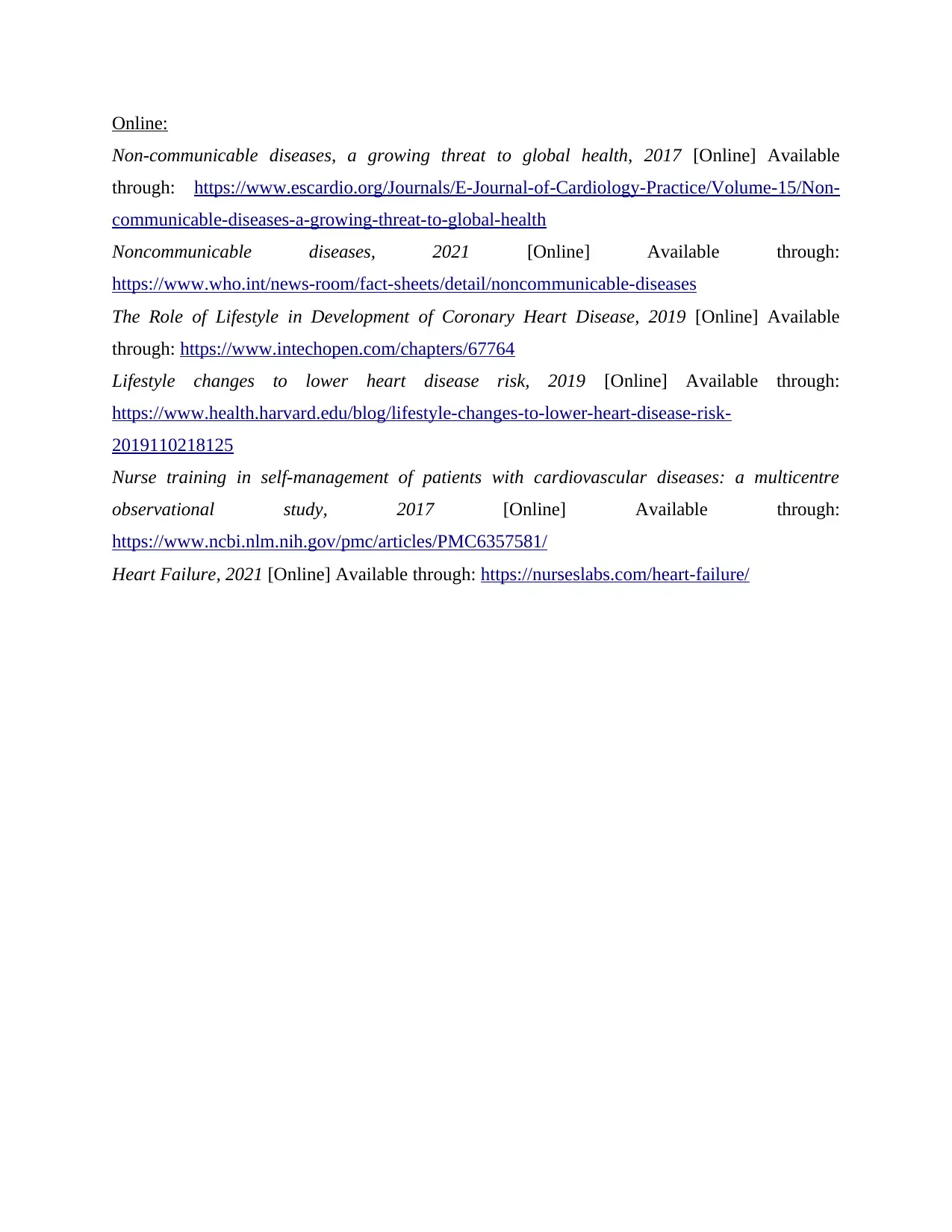
Online:
Non-communicable diseases, a growing threat to global health, 2017 [Online] Available
through: https://www.escardio.org/Journals/E-Journal-of-Cardiology-Practice/Volume-15/Non-
communicable-diseases-a-growing-threat-to-global-health
Noncommunicable diseases, 2021 [Online] Available through:
https://www.who.int/news-room/fact-sheets/detail/noncommunicable-diseases
The Role of Lifestyle in Development of Coronary Heart Disease, 2019 [Online] Available
through: https://www.intechopen.com/chapters/67764
Lifestyle changes to lower heart disease risk, 2019 [Online] Available through:
https://www.health.harvard.edu/blog/lifestyle-changes-to-lower-heart-disease-risk-
2019110218125
Nurse training in self-management of patients with cardiovascular diseases: a multicentre
observational study, 2017 [Online] Available through:
https://www.ncbi.nlm.nih.gov/pmc/articles/PMC6357581/
Heart Failure, 2021 [Online] Available through: https://nurseslabs.com/heart-failure/
Non-communicable diseases, a growing threat to global health, 2017 [Online] Available
through: https://www.escardio.org/Journals/E-Journal-of-Cardiology-Practice/Volume-15/Non-
communicable-diseases-a-growing-threat-to-global-health
Noncommunicable diseases, 2021 [Online] Available through:
https://www.who.int/news-room/fact-sheets/detail/noncommunicable-diseases
The Role of Lifestyle in Development of Coronary Heart Disease, 2019 [Online] Available
through: https://www.intechopen.com/chapters/67764
Lifestyle changes to lower heart disease risk, 2019 [Online] Available through:
https://www.health.harvard.edu/blog/lifestyle-changes-to-lower-heart-disease-risk-
2019110218125
Nurse training in self-management of patients with cardiovascular diseases: a multicentre
observational study, 2017 [Online] Available through:
https://www.ncbi.nlm.nih.gov/pmc/articles/PMC6357581/
Heart Failure, 2021 [Online] Available through: https://nurseslabs.com/heart-failure/
1 out of 10
Related Documents
Your All-in-One AI-Powered Toolkit for Academic Success.
+13062052269
info@desklib.com
Available 24*7 on WhatsApp / Email
![[object Object]](/_next/static/media/star-bottom.7253800d.svg)
Unlock your academic potential
Copyright © 2020–2025 A2Z Services. All Rights Reserved. Developed and managed by ZUCOL.





